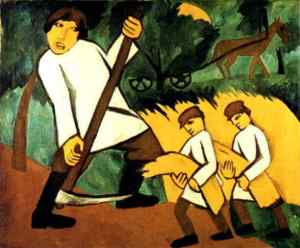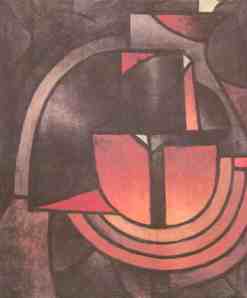Two major figures who influenced the development in modern art in respectively Russia and Georgia are Nataliya Goncharova and David Kakabadze. Comparing their artworks, will lead to a more comprehensive overview of the developments of those times, as Goncharova clearly had the desire to move away from the West, and Kakabadze, on the other hand, was obsessed with accumulating as much different views on art and sciences during his life. In the following essay two of their paintings will be analyzed, the neo-primitive work ʻHay Cuttingʼ by Nataliya Goncharova in 1910, and David Kakabadzeʼs cubist self-portrait of 1914. Although both artworks are very different in style, and both artists have made works which are more alike, it is interesting to compare these two, as Goncharova was very much interested in the works of Georgian self-taught artist Niko Pirosmanishvili and was not impressed by cubism on its own, while Kakabadze was experimenting with different styles at the same time.
Hay-Cutters – Nataliya Goncharova, 1910
 ʻWe have learned much from Western artists, but from where do they draw their inspiration, if not from the East?’. In her 1912s essay on neo-primitivism, Nataliya Goncharova explains her rejection of the west and her interest in old forms of art. Already for several years before 1912, she and her partner Mikhail Larionov were intrigued with folk art, children’s paintings and self-taught artists, such as Georgian Niko Piromanishvili.
ʻWe have learned much from Western artists, but from where do they draw their inspiration, if not from the East?’. In her 1912s essay on neo-primitivism, Nataliya Goncharova explains her rejection of the west and her interest in old forms of art. Already for several years before 1912, she and her partner Mikhail Larionov were intrigued with folk art, children’s paintings and self-taught artists, such as Georgian Niko Piromanishvili.
As explained by Goncharova, the need to go back to these naive forms of art, are necessary to find new forms.
Moreover, Goncharova was clearly inspired by her own countryʼs traditions and culture, and argued that the folklore colors and surroundings of the East and Russia should be part of modern art in order to create something new: ʻI aspire toward nationality and the East, not to narrow problems of art but, on the contrary, to make it all-embracing and universalʼ.
In her neo-primitivist work of 1910, ʻHay Cuttingʼ, her search for naive forms, the east and parts of the russian nationality can be evidentially traced back. Although the work obviously has elements of Cubism and Gauguin (a symbolist western artist), the rural sight depicts a very Russian subject. Furthermore, the colors, the lines, the flatness and the deformed characters show the spectator Goncharovaʼs inspiration for this artwork: primitive, naive art.
David Kakabadze, Cubist self-portrait, 1914
Although both Nataliya Goncharova and David Kakabadze shared their love for the works of Georgian self-taught painter Niko Pirosmani, they differed opinion on several other subjects. For instance, Goncharova stated in her introduction on Cubism in 1912 that the artists had gone too much into theory and, in doing so, had lost the soul of art; however, David Kakabadze believed that in order to find the ʻtrueʼ art, one should study as much as one could about it. As he said while living in Paris in the 1920s: “First Theory, then practice”.
Kakabadze identified himself with masterʼs such as Leonardo da Vinci; as his desire was to not only be a painter, but also a philosopher and a scientist. His theory entailed that all is interconnected, and in order to understand all aspects of life, one ought to study all.
For him his artistic works were both a foundation for, as the result of, his search for knowledge: ʻPainting is nearly the philosophy of natureʼ.
His quest to learn as much about art and life in general already started in 1911 when he received a scholarship to study in St. Petersburg. Although he was more interested in studying at the Academy of Arts, he was not accepted there because his drawings were not well developed yet, however, he did not want to waste time and decided to study Physics. Nevertheless, he did take some classes in drawing at the studio of Lev Dmitriev-Kavkazskii, and painted among his famous ʻMother and Imeretiʼ and ʻSelf-portrait with pomegranatesʼ, his cubist self-portrait (1914).
It is important to note that Kakabadzeʼs cubism is different from European style cubism, such as Pablo Picassoʼs. Although there are some linkages with cubist artis George Braque when it comes to his analytical approach, Kakabadze was not concerned with the form, but rather with colors and unification of the forms. His obsession with color, the expressiveness of color and forms, are very distinct and could be categorized as a form of ʻGeorgian Cubismʼ.
Although both Goncharova and Kakabadze had several different influences, their artwork at times is comparable and at times is not. With Goncharova it is eminent that her artworks have influenced the manner in which Russian modern art developed before she left for Paris after the Bolsheviks took power. However, the influence of Kakabadze on the Georgian modern art field should not be disregarded either. Both had in common their desire to find new art forms, to find a true language of art, and both have attempted so in different ways – Goncharovaʼs neo-primitive and Kakabadzeʼs cubo-futurist influenced artworks are perfect examples of their strategy.
link: facebook.com/adjapsandali












No comments:
Post a Comment